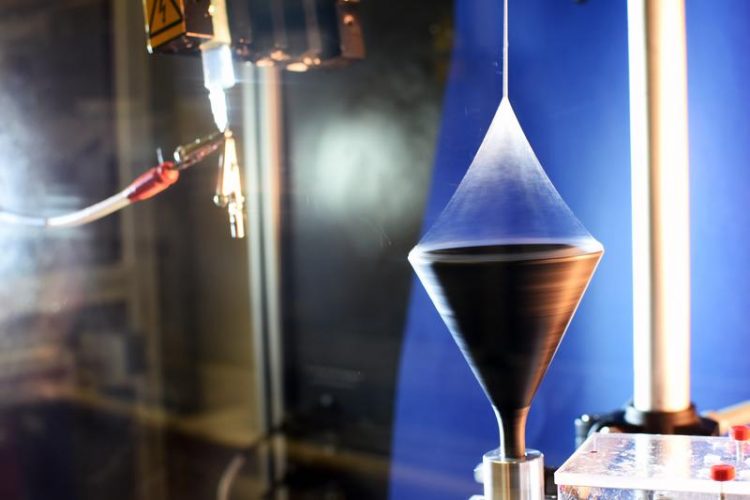Light, strong, and tough: Researchers at the University of Bayreuth discover unique polymer fibres

Electrospinning of a multifibrillar polyacrylonitrile fiber. Photo: University of Bayreuth / Jürgen Rennecke
“The fibres we discovered can be produced easily using high-tech processes that are already established in the industry – and on the basis of polymers that are readily available worldwide. One individual fibre is as thin as a human hair, weighs less than a fruit fly, and yet is very strong: It can lift a weight of 30 grams without tearing.
This corresponds to about 150,000 times the weight of a fruit fly. Experiments on the high tensile strength of these fibres have furthermore revealed their high toughness. This means that each individual fibre can absorb a lot of energy,” explains Prof. Dr. Andreas Greiner, who is the head of the research group Macromolecular Chemistry II at the University of Bayreuth, and who guided the research work.
Also involved were researchers at the Forschungszentrum Jülich, the Martin Luther University Halle-Wittenberg, the Fraunhofer-Institute for Microstructure of Materials and Systems (IMWS), the Rheinisch-Westfälische Technische Hochschule Aachen University, the Jiangxi Normal University, Nanchang, and the ETH Zürich.
Due to their unique properties, the polymer fibres are ideally suited for technical components that are exposed to high loads. They enable innovative applications in a wide variety of fields, for example in the textile industry or medical technology, in automotive engineering, or in the aerospace industry. In addition, the polymer fibres can be recycled well.
“We are certain that our research results have opened the door to a new, forward-looking class of materials. Practical applications on the part of industry can be expected in the near future. In polymer science, our fibres will be able to provide valuable services in the further research and development of high-performance functional materials,” says Greiner.
The chemical basis of these promising fibres is polyacrylonitrile. A single fibre with a diameter of about 40,000 nanometres consists of up to 4,000 ultra-thin fibrils. These fibrils are linked by small amounts of an additive. Three-dimensional X-ray images show that the fibrils within the fibre are almost always arranged in the same longitudinal direction.
“We prepared these multifibrillar polyacrylonitrile fibers in a laboratory for electrospinning at the University of Bayreuth and extensively tested them for their properties and behaviour. Their unique strength in combination with high toughness never ceased to fascinate us,” reports the Bayreuth polymer scientist Prof. Dr. Seema Agarwal.
The lead author of the study published in “Science” is Xiaojian Liao, a doctoral researcher in chemistry in Bayreuth. “I am very pleased that I was able to contribute to this research success in materials science as part of my doctoral thesis. The intensive interdisciplinary contact between chemistry, physics, and material sciences on the Bayreuth campus has provided some critical impetus in recent years,” says Liao.
Photos for Download:
https://www.uni-bayreuth.de/en/university/press/press-releases/2019/160-polymer-…
Video reporting on the new polymer fibres:
https://youtu.be/m9khIspNmUo
Prof. Dr. Andreas Greiner
University of Bayreuth,
Chair of Macromolecular Chemistry II and Bavarian Polymer Institute (BPI)
Phone: +49 (0)921 / 55-3399
E-Mail: andreas.greiner@uni-bayreuth.de
Xiaojian Liao, Martin Dulle, Juliana Martins de Souza e Silva, Ralf B. Wehrspohn, Seema Agarwal, Stephan Förster, Haoqing Hou, Paul Smith, Andreas Greiner: High strength in combination with high toughness in robust and sustainable polymeric materials. Science (2019), DOI: http://dx.doi.org/10.1126/science.aay9033.
In the same issue, Science has published an own article about these research results:
https://science.sciencemag.org/content/366/6471/1314
Media Contact
All latest news from the category: Materials Sciences
Materials management deals with the research, development, manufacturing and processing of raw and industrial materials. Key aspects here are biological and medical issues, which play an increasingly important role in this field.
innovations-report offers in-depth articles related to the development and application of materials and the structure and properties of new materials.
Newest articles

Properties of new materials for microchips
… can now be measured well. Reseachers of Delft University of Technology demonstrated measuring performance properties of ultrathin silicon membranes. Making ever smaller and more powerful chips requires new ultrathin…

Floating solar’s potential
… to support sustainable development by addressing climate, water, and energy goals holistically. A new study published this week in Nature Energy raises the potential for floating solar photovoltaics (FPV)…

Skyrmions move at record speeds
… a step towards the computing of the future. An international research team led by scientists from the CNRS1 has discovered that the magnetic nanobubbles2 known as skyrmions can be…





















